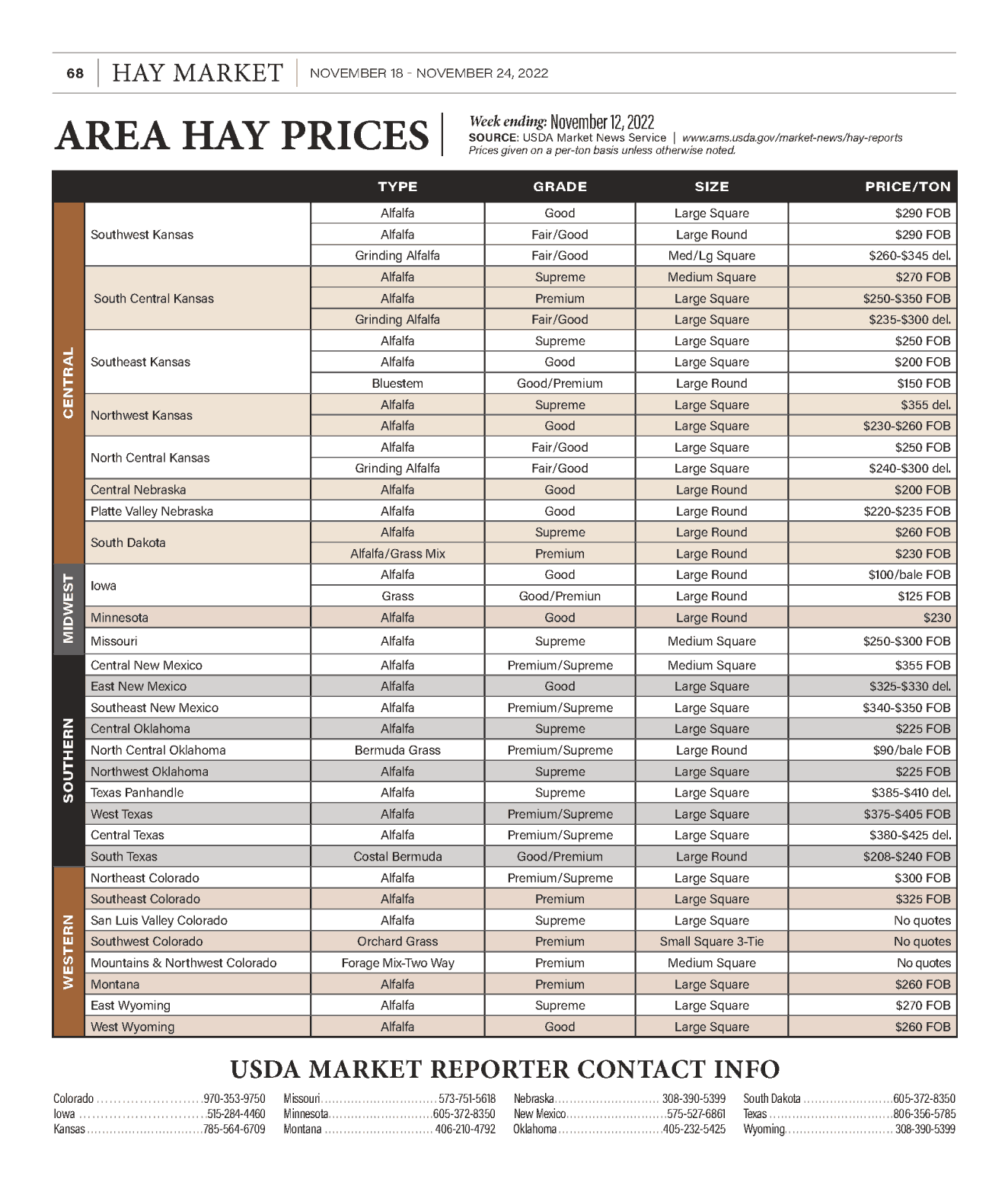Colorado—In the Nov. 11 report, compared to last report, trade activity remained moderate with very good demand for horse hay; prices remained mostly steady. Feedlot hay trades were light with light to moderate demand. According to the NASS Colorado Crop Progress Report for the week ending Nov. 6, fourth cutting alfalfa harvested is 90% compared to 93% from last year. Stored feed supplies were rated 21% very short, 26% short, 50% adequate, and 3% surplus
Missouri—In the Nov. 10 report, compared to last report, hay movement remains good, the supply of hay is light to moderate and demand is moderate and prices mostly steady. Weather around the state continues to be very volatile as the seasons try to figure out what to do. The drought monitor continues to slowly show improvement. Although the growing season is over moisture is quite welcome to fill ponds and add to the extremely depleted soil.
Nebraska—In the Nov. 10 report, compared to last week, all reported forages sold fully steady across the state. Demand was moderate to good. Prices continue to vary across the state for the same types of hay being sold. Most contacts are getting down to the end of the 2022 hay. A few contacts in the west are going to carry over some hay into January of 2023 and will market it then. Most fall crops have been harvested with quite a lot of cornstalks and soybean stubble getting baled.
Oklahoma—In the Nov. 11 report, compared to the last report, not much has changed. Hay volume continues to lower. With the drought there is more hay coming into Oklahoma and being traded compared to trading the Oklahoma hay crop.
Texas—In the Nov. 10 report, compared to the last report, hay prices are steady to firm in all regions. Hay demand is picking up as the majority of the pastures in the state are rated from average to very poor. Additionally, a cold front is moving into the area which will increase supplemental livestock feeding. Hay is still moving into the state from bordering states, but trucking and freight rates continue to be a struggle for producers and have had large impacts on delivered prices. According to USDA-NASS, winter wheat planting across the state reached 88%, up 5 points from the previous year. Winter wheat emergence has reached 67%, up 5 points from the previous year. Although rains have been scarce they’ve been pretty timely for the winter wheat crop thus far. The productivity of winter wheat crop will be very important for livestock producers as forages are predicted to be short this year. Next report will be released Nov. 25.
New Mexico—In the Nov. 4 report, compared to last week, alfalfa hay prices steady. Trade active, demand very good. A cold front moved in across New Mexico dropping temperatures down to freezing in some areas. This is the last report of the season. Next report will be released April 2023.
South Dakota—In the Nov. 11 report, compared to last week, all classes of hay remain steady to firm. Very good demand for all types and qualities of hay. Calves are arriving in feedyards and needing high quality grass hay to get them started on feed, which is adding strength to the grass hay market. High quality dairy hay remains tough to find as the drought really diminished the overall tonnage of alfalfa. A lot of corn stalks bales were made this year as the dry fall weather made for ideal baling conditions and there is a lot of demand for these bales as cattle producers use these to grind and blend in their rations to stretch their forage supplies.
Wyoming—In the Nov. 10 report, compared to last week, all reported prices for hay sold fully steady. Demand remains good for any type of baled product. Some light snow showers in with western side of the state. Mostly dry in other areas. Cooler temps are in the forecast.
Montana—In the Nov. 11 report, compared to last report, hay sold generally steady. Demand for hay this week was mostly moderate for moderate offerings. High quality dairy hay sold on moderate demand this week. Local hay sales were slow this week as most of the larger hay sales this week sold outside of the state. Many producers are busy hauling cows and calves and were not as active in selling hay locally this week. Heavy supplies continue to enter the state both from the Dakotas and Canada.



